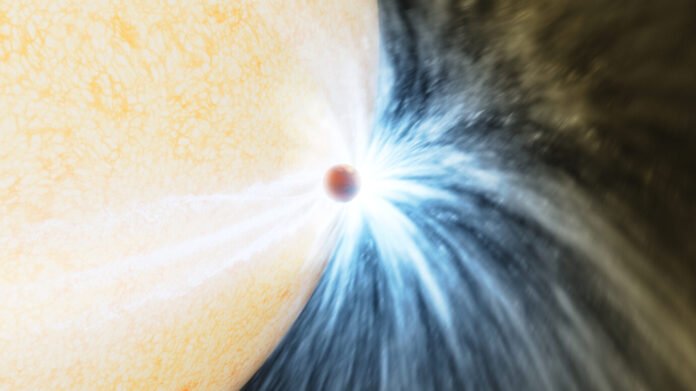For the first time, telescopes observe a planeta 10 times heavier than Jupiter being swalloed by a star at 12,000 light-years of distance.
Fonte: Science
Researchers spotted the event some 12,000 light-years away in the constellation Aquila while searching for the fireworks associated with stellar mergers. The relatively minor cataclysm, which flared only 1/1000th as brightly as a binary star merger, could open a whole new field of study, researchers say.
Astrophysicists have long known that when a Sun-like star runs out of fuel, it becomes a red giant, big enough to engulf any close-orbiting planets. The growth occurs when a star exhausts the hydrogen fuel in its core and the fusion reactions that make the star shine spread outward in search of more fuel, swelling the star’s outer layers. That means the Sun will eventually envelop Earth and the other rocky planets—although it won’t happen for another 5 billion years.

Such an event had never been seen—until now. In May 2020, Kishalay De, an astronomer at the Massachusetts Institute of Technology, and colleagues were studying data from the Zwicky Transient Facility, an optical survey telescope at the Palomar Observatory in California. They were on the lookout for the characteristic brightening of a merging of two stars, known as a red nova. Instead, the researchers found something much more mysterious.
One star—later dubbed ZTF SLRN-2020—grew 100 times brighter over the course of 10 days before slowly fading. Unsure what it was, the team obtained the star’s spectrum—a breakdown of its brightness across different wavelengths—from one of the giant W.M. Keck Observatory telescopes in Hawaii. The merger of two stars typically produces lots of superhot hydrogen and helium, which leaves bright emission lines in the spectrum, but these were missing. Instead, the researchers saw emissions from much cooler molecular gases, not the sort of thing they would expect from the merger of stars.
ZTF SLRN-2020 remained a puzzle until a year later, when the team analyzed its spectrum at infrared wavelengths with Palomar’s Hale Telescope and found that it was still astonishingly bright. Looking back in archives, they saw that it began to brighten in the infrared some 7 months before the sudden optical flare they’d originally discovered. Slowly, a picture began to emerge.
As the star swelled, a companion object began to rub up against its outer layers, heating them up and causing them to brighten in the infrared. The friction would also have degraded the companion’s orbit until it plummeted into the star. That dive would inject a lot of gravitational energy into the star, puffing it up so that it flared brightly at optical wavelengths. As it cooled and shrank again over the following months—so that the optical flash faded—some stellar material was left behind as a veil of glowing dust, which explains the long-lived infrared brightness.
Although the evolution and spectra of the event resembled a binary star merger, its dimness pointed to a star-planet merger instead. The star merged with something 1/1000th of a star’s mass, the researchers report today in Nature. That would make it a planet roughly the size of Jupiter.



